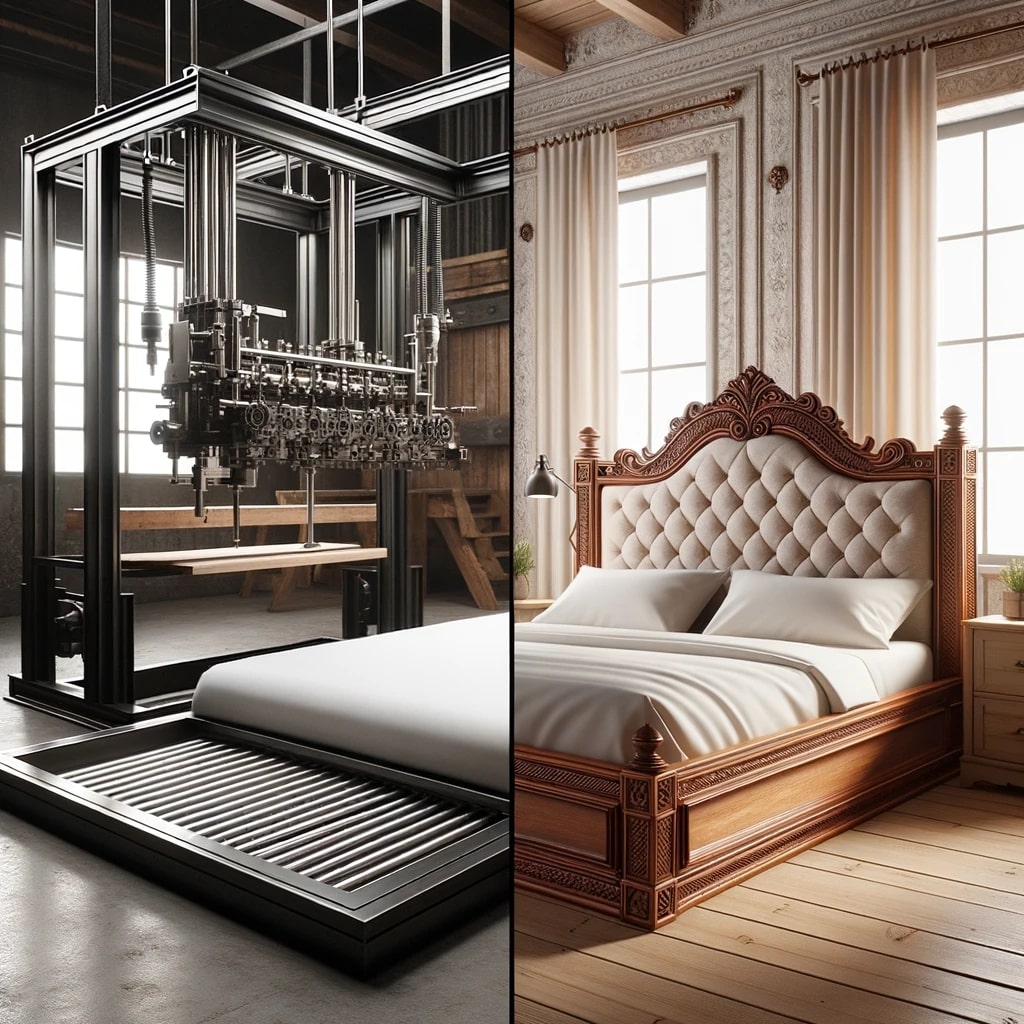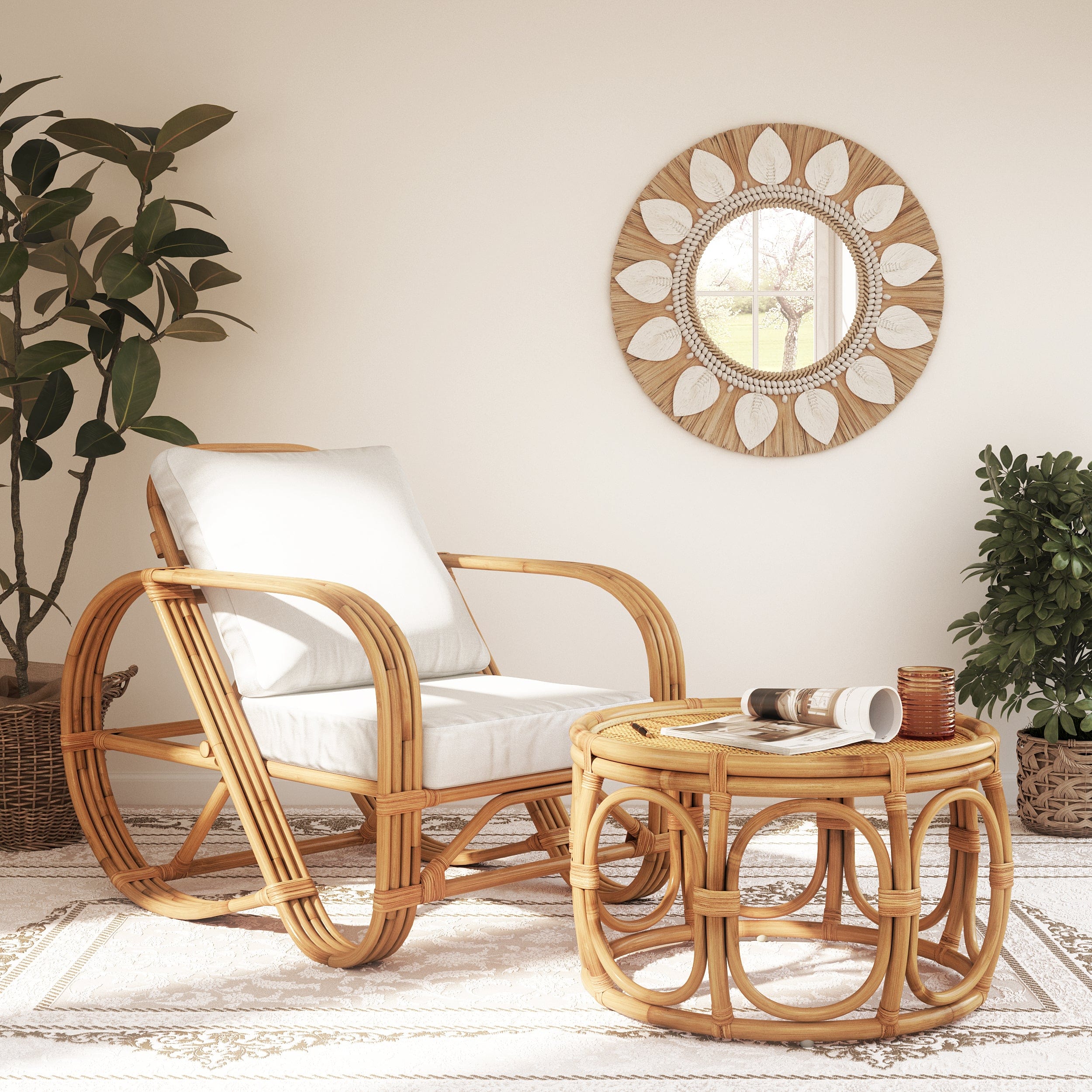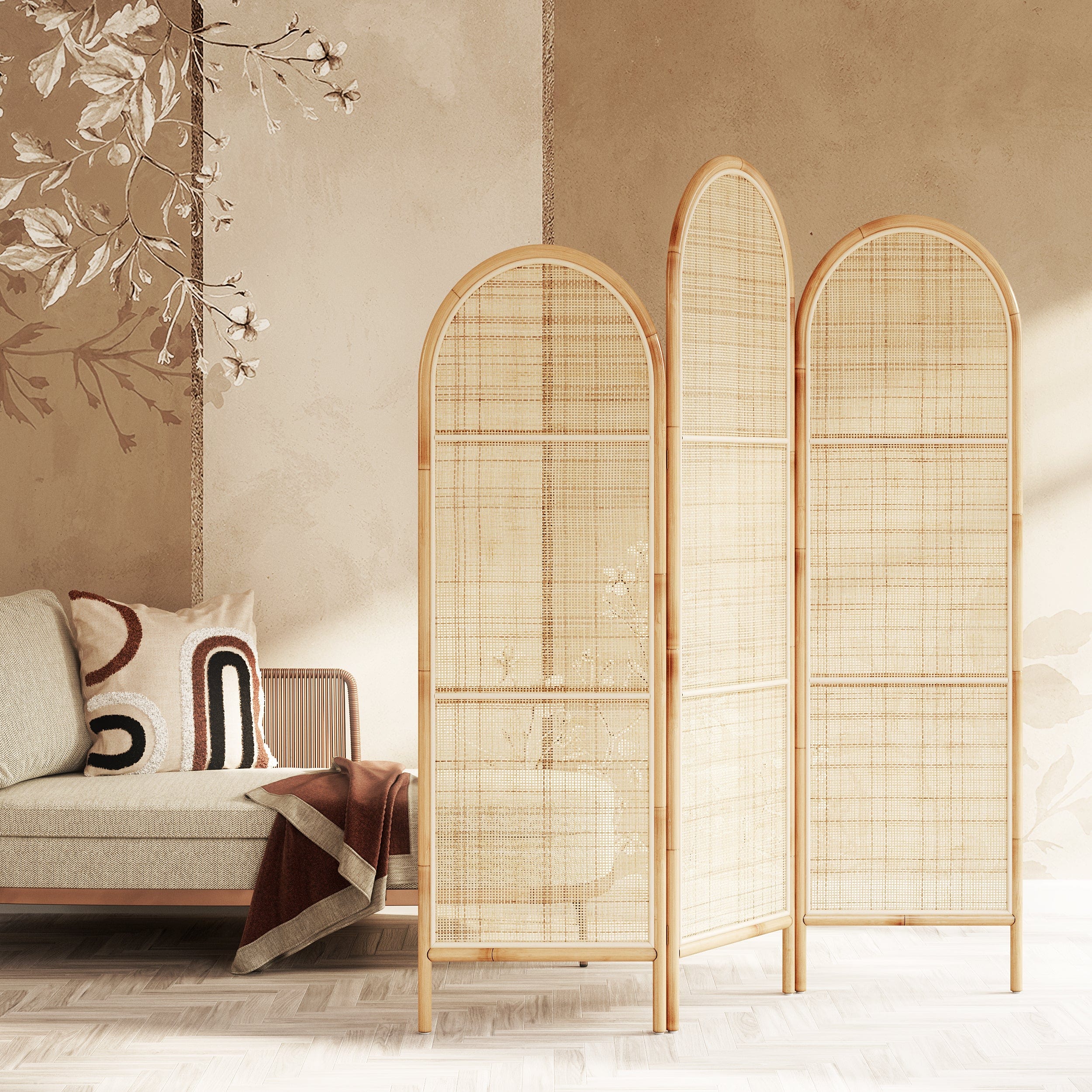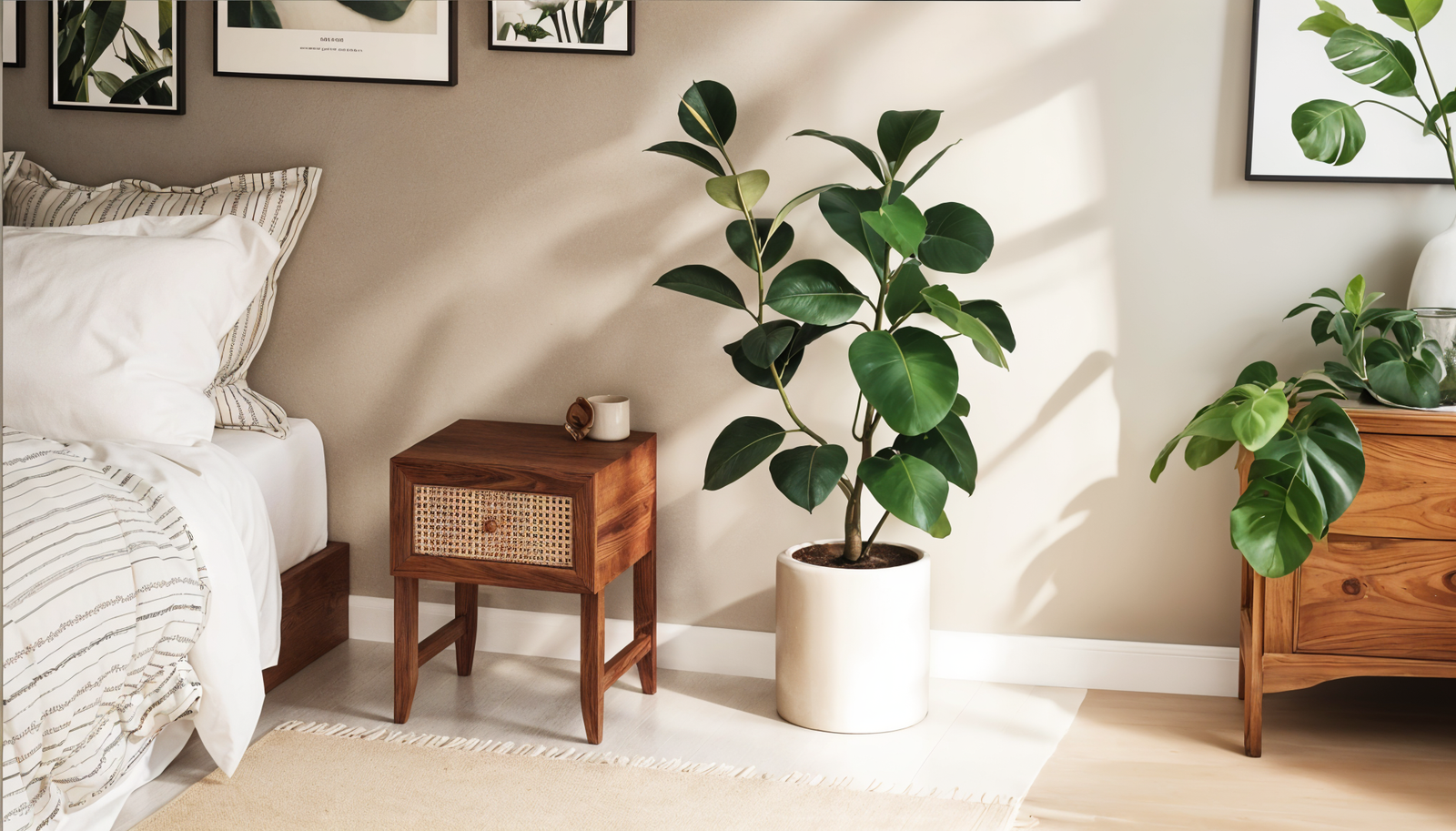🤍 Unmatched Quality, Authentic Craftsmanship
🤍 Unmatched Quality, Authentic Craftsmanship
🤍 Unmatched Quality, Authentic Craftsmanship
Furniture is an essential part of our lives, providing us with comfort, style, and functionality.
When it comes to furniture, there are two main categories to choose from: machine-made and handmade.
Each has its own unique characteristics and benefits, making it important to understand the differences before making a purchase.
Machine-made furniture is produced in large quantities using automated processes, while handmade furniture is crafted by skilled artisans using traditional techniques.
The distinction between the two goes beyond just the manufacturing process; it also affects the quality, durability, and overall aesthetic of the furniture, as well as its uniqueness.

In this comparison guide, we will delve into the specific features, considerations, and pros and cons of both machine-made and handmade furniture.
By understanding the pros and cons of each, you can make an informed decision about which piece of furniture aligns with your personal preferences and budget.
Whether you're looking for furniture that is mass-produced and affordable or one-of-a-kind and artisanal, this guide will help you navigate the world of furniture shopping with confidence.
Before we go into the key differences between machine-made and handmade furniture, have you ever wondered how furniture is made?
Let’s take a look at how each is produced.
There are two main types of furniture manufacturing: machine-made and handmade.
Each process has its own advantages and disadvantages, and the best choice for you will depend on your individual needs and preferences.
Machine-made furniture or factory-made furniture is created using automated processes, while handmade furniture is crafted by skilled artisans using traditional techniques.
Machine-made furniture is usually produced in large quantities and is typically less expensive than handmade furniture.
This type of furniture is created through a series of automated steps that involve cutting, shaping, and assembling the pieces.
Handmade furniture is crafted by skilled artisans using traditional methods and natural materials.
The production of handmade furniture typically takes more time, skill, and attention than machine-made pieces.
It is created using a variety of traditional techniques such as woodworking, carving, inlaying, gilding, upholstery work, and more.
Artisans often incorporate their own unique styles into the designs, which can add a special touch to each piece.
Handcrafted furniture is usually one-of-a-kind and more expensive than machine-made furniture.
Now that we have understood the manufacturing process of each type, let’s take a look at the biggest factors to consider when choosing between the two.
When choosing between machine-made and handmade furniture, there are a few important considerations to make.
Let's explore each of these factors in detail.
When it comes to furniture, you absolutely cannot compromise on quality and durability.
The quality and durability of either piece of furniture are decisive factors in deciding whether to purchase it or not.
If the furniture's quality does not meet your expectations, then it is likely that it will not last very long, and you may end up having to replace it sooner than expected.
Machine-made furniture
Machine-made furniture is generally of lower quality and less durable than handmade furniture due to the automated processes used in its manufacture.
The materials used are often of lower quality and not designed to last as long as those used in handmade pieces.
Additionally, machine-made furniture pieces tend to be uniform in design and style, meaning they lack the uniqueness of handmade items.
Quality control is also more difficult to maintain with mass-produced items.
Handmade furniture

Handmade furniture is of higher quality and generally more durable than machine-made furniture due to its craftsmanship.
The materials used in handmade pieces are of a much higher grade and are designed to withstand the test of time.
The skilled people involved in crafting each piece mean that attention is paid to every detail, and all components are built with exceptional care.
In short, handmade furniture is simply of higher quality and more durable than its machine-made counterpart.
When it comes to furniture, whether for your home or office, many people prefer a unique look and feel.
Why is uniqueness important? Well, it can help to set your home apart and make it stand out from the crowd.
Machine-made furniture
Machine-made furniture is typically produced in large quantities and with automated processes, meaning that the majority of pieces are uniform in design and style.
This means that there is a lack of uniqueness when compared to handmade furniture, as mass-produced items tend to be more generic due to their uniformity.
Additionally, machine-made furniture lacks the attention to detail that comes with handmade pieces, as they are often crafted by machines rather than skilled artisans.
Handmade furniture

Handmade furniture is often one-of-a-kind due to its unique construction, as each piece is crafted with individual care and attention.
The skilled artisans who create handmade pieces are dedicated to producing superior products that stand out from mass-produced items.
The labor involved in crafting each piece allows for intricate details and customized looks that are not possible with mass-produced furniture.
The emphasis on individuality results in furniture that embodies a distinct look and feel.
Handmade furniture often features intricate details and customized looks that are not possible with machine-made items.
The use of higher-grade materials and superior construction techniques also ensures the longevity of each piece, making it an investment that is sure to last for years to come.
In short, handmade furniture is more unique and of higher quality than its machine-made counterpart.
When choosing between machine-made and handmade furniture, customization is also an important factor to consider.
Customization allows you to create unique pieces that are tailored to your individual preferences and needs.
Machine-made furniture
Machine-made furniture is typically not customizable, as it is mass-produced with automated processes.
While some companies offer a few color and finish options, the majority of machine-made pieces are uniform in design and style.
This means that the end product lacks individuality and cannot be tailored to meet specific needs or preferences.
Additionally, the lack of skilled artisans involved in the process can lead to imperfections and irregularities in the finished product.
Handmade furniture

Handmade furniture is often highly customizable, as the skilled artisans who craft each piece are dedicated to creating a unique look and feel.
The labor involved in crafting each item allows for intricate details and customized looks that cannot be achieved with mass-produced items.
This ensures that each piece is tailored to meet specific needs or preferences.
Additionally, handmade furniture is often crafted with higher-grade materials and superior construction techniques, making it more durable than its machine-made counterparts.
In short, handmade furniture is more customizable and durable than its machine-made counterpart.
When it comes to furniture, sustainability is an important factor to consider.
Sustainable furniture is crafted with materials that are sourced responsibly and designed to last for many years.
Does sustainability matter?
Well, of course. It is very important to consider the environmental impact of any furniture purchase.
Machine-made furniture
Machine-made furniture is often produced with materials that are not sustainably sourced, resulting in a negative environmental impact.
Automated processes also require high levels of energy, resulting in significant carbon emissions.
Additionally, the uniform design and construction of machine-made furniture means that pieces are more likely to be discarded after a short period due to their lack of uniqueness and quality.
This contributes to the waste and pollution in our environment.
Handmade furniture

Handmade furniture is often crafted with sustainably sourced materials, resulting in a much lower environmental impact.
The labor-intensive process of crafting each piece also results in much lower energy usage when compared to machine-made furniture.
Additionally, handmade pieces are often designed to last for years due to their superior construction and materials.
This extends the life of the furniture and reduces the amount of waste in our environment.
In short, handmade furniture is a much more sustainable option than its machine-made counterpart.
Accessibility refers to the availability and affordability of furniture.
When considering the differences between machine-made and handmade furniture, accessibility is also an important factor to consider.
Each furniture type has its own unique advantages in terms of accessibility.
Machine-made furniture
Machine-made furniture is much more accessible than handmade furniture due to its mass production.
It is typically easier to find and less expensive than handmade furniture, making it a great option for those on a budget.
Additionally, machine-made furniture often comes with assembly instructions and can be put together without the assistance of a professional craftsperson.
This makes it convenient and relatively easy to set up in one's home.
Handmade furniture
Handmade furniture is typically not as accessible as machine-made furniture due to its limited availability.
It is produced in smaller quantities and can be difficult to find.
Handmade furniture can be seen as an investment, as it holds its value over time due to its unique craftsmanship and quality.
These pieces often become family heirlooms, passed down from generation to generation.
Additionally, handmade furniture is often exclusive and one-of-a-kind, meaning that no two pieces are ever exactly alike. As such, these pieces often carry a special significance for the owner.
In short, machine-made furniture is more accessible and affordable, while handmade furniture is a more exclusive and unique option.
The most important factor to consider in any purchase is the cost.
When buying furniture, it is not just about the need but also the budget.
Which piece of furniture is worth buying in the long run? You can find it below.
Machine-made furniture
Machine-made furniture is typically less expensive than handmade furniture.
This is due to the fact that it is produced in large quantities and with automated processes, making it less expensive to manufacture.
Machine-made furniture tends to be uniform in design and style, allowing for the mass production of a single piece without needing to be customized.
Because of this, buyers can expect lower prices when compared to handmade pieces.
Handmade furniture
Handmade furniture, on the other hand, has a higher price tag due to the time and skill required in its production, with prices varying widely depending on the quality of craftsmanship and materials used.
Handmade furniture is crafted by skilled artisans using traditional techniques, making each piece unique and one-of-a-kind.
Handmade pieces are generally much sturdier than mass-produced furniture, as the labor and materials used in their construction are of a higher quality than those used for machine-made pieces.
In short, machine-made furniture is more affordable, while handmade furniture carries a higher price tag due to its craftsmanship and materials.
Now that you know some key factors to consider when comparing machine-made and handmade furniture, let's delve into some of the pros and cons of each so you can make an informed decision about the type of furniture that is best for your home.
We have discussed many factors to consider when comparing the two types of furniture.
However, the pros and cons will help to summarize the main differences between machine-made and handmade furniture.
Let’s take a look at some pros and cons of each that will help you decide which type of furniture is right for you.
Machine-made furniture has its own advantages. Some of these are listed below.
More affordable:
Machine-made furniture is generally less expensive than handmade furniture due to the economies of scale associated with mass production.
More readily available:
Machine-made furniture is typically more readily available than handmade furniture, as it is produced in large quantities.
In short, machine-made furniture is a great option if you are looking for an affordable piece of furniture that is widely available.
Machine-made furniture has some cons that may be worth considering before you make a purchase. These are as follows:
Lower quality:
Machine-made furniture is often made from lower-quality materials and construction methods than handmade furniture in order to reduce costs.
Less unique:
Machine-made furniture is typically mass-produced, so it is less unique than handmade furniture.
Less durable:
Machine-made furniture is often less durable than handmade furniture, as it is made from lower-quality materials and construction methods.
Negative environmental impacts:
Machine-made furniture is often made in ways that are not environmentally friendly, such as using materials with toxic chemicals or processes that generate a lot of waste.
In short, machine-made furniture may have its advantages, but it is important to be aware of the potential downsides before making a purchase.

Handmade furniture has lots of advantages, some of which are as follows:
Higher quality:
Handmade furniture is typically made from higher-quality materials and construction methods than machine-made furniture.
More unique:
Handmade furniture is typically one-of-a-kind, as it is made by a skilled craftsman.
More durable:
Handmade furniture is typically more durable than machine-made furniture, as it is made from higher-quality materials and construction methods.
More sustainable:
Handmade furniture is often made from sustainable materials and practices, which can be more environmentally friendly than machine-made furniture.
In short, if you are looking for a piece of furniture that is of high quality, unique, and durable, then handmade furniture may be the right choice for you.
With lots of advantages, there are a few potential cons to consider when looking at handmade furniture. These are as follows:
More expensive:
Handmade furniture is generally more expensive than machine-made furniture due to the higher cost of materials and labor.
Less readily available:
Handmade furniture is typically less readily available than machine-made furniture, as it is produced in smaller quantities.
In short, handmade furniture is a great option if you are looking for a high-quality and unique piece of furniture, but it is important to consider the potential downsides before making a purchase.
The pros and cons of each type of furniture will help you determine which is right for your home.
In the next section, we will explore some of the commonly asked questions about machine-made and handmade furniture to help you make an informed decision while shopping for furniture.
After going through the information above, you might still have some lingering questions about the difference between machine-made and handmade furniture.
In this section, we aim to answer some of the frequently asked questions regarding this topic. Let's take a look:
Yes, it is possible to customize machine-made furniture to the same extent as handmade pieces.
The customization process depends on the manufacturer and type of furniture.
Many machine-made pieces come with customizable features such as size, material, color, and style.
If these options are not available from the manufacturer, it may be possible to customize the piece through a third-party service or by working with a skilled craftsperson.
Yes, there are several environmental benefits to choosing handmade furniture over machine-made.
Handmade furniture is typically made from sustainable materials such as wood, organic fabrics, and natural fibers.
This reduces the impact on the environment by reducing the use of chemicals or other pollutants during production.
Additionally, the slower production process employed by handmade pieces results in fewer resources being used, helping to reduce one's carbon footprint.
Yes, it is possible to find machine-made furniture that mimics the look of handmade craftsmanship.
Manufacturers are often able to use special techniques and materials to replicate the unique characteristics of handmade furniture.
For example, some pieces may be made from solid hardwood or have detailed carvings that give them an appearance similar to handmade pieces.
Additionally, some manufacturers utilize advanced technology, such as 3D printing, to create furniture that looks and feels like it has been crafted by hand.
Yes, there are several regions and cultures known for producing exceptional handmade furniture.
Scandinavia is known for its high-quality craftsmanship and contemporary designs that have become popular around the world.
Additionally, France is renowned for its elegant pieces that are imbued with a classic style.
The United Kingdom is also well regarded for its expertly produced antique furniture from the 17th to 19th centuries.
Finally, Indonesia is home to a variety of artisan pieces that are inspired by traditional designs and techniques.
Yes, it is possible to repair and restore machine-made furniture just as easily as handmade pieces.
While the process may differ slightly depending on the materials used and the type of furniture, many machine-made pieces can be repaired without having to replace any parts or components.
This is due to the fact that most manufacturers use durable materials such as metal or wood in their construction.
Additionally, modern technology has allowed for the development of advanced repair methods that make it easier to restore furniture to its original condition.
The resale value of machine-made furniture can vary widely depending on the quality of the materials used in its construction and how well it has been cared for.
Generally speaking, machine-made pieces tend to have lower resale values than handmade pieces due to their mass production.
However, certain types of high-end machine-made furniture can be just as valuable as handmade pieces if they are of exceptional quality and have been well cared for.
When it comes to choosing between machine-made and handmade furniture, it ultimately depends on your preferences and priorities.
Machine-made furniture offers affordability, consistency, and availability, while handmade furniture provides uniqueness, craftsmanship, and a personal touch.
Both types have their own advantages and disadvantages, so it's important to consider factors such as budget, style and desired quality when making your decision.
By understanding the differences between the two, you can make an informed choice that aligns with your needs and preferences.


